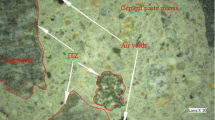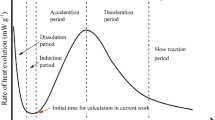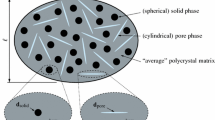Abstract
A digital image-based model of the microstructure of cement paste, coupled with exact transport algorithms, is used to study the diffusivity of Portland cement paste. The principal variables considered are water∶cement ratio, degree of cement hydration and capillary porosity. Computational methods are described and diffusivity results are presented, which are found to agree with the available experimental measurements within experimental error. Model cement pastes prepared with different water∶cement ratios, and having different degrees of hydration, are found to have diffusivities that lie on a single master curve when plotted as a function of capillary porosity. Concepts from percolation theory are used to explain quantitatively the dependence of diffusivity on capillary porosity. The effect of silica fume addition on diffusivity is also examined.
Similar content being viewed by others
References
L. M. Schwartz andJ. R. Banavar,Phys. Rev. B,39 (1989) 11965.
V. K. S. Shante andS. Kirkpatrick,Adv. Phys. 20, (1971) 325.
A. Atkinson andA. K. Nickerson,J. Mater. Sci. 19 (1984) 3069.
A. H. Thompson, A. J. Katz andC. E. Krohn,Adv. Phys. 36 (1987) 625.
J. Pommersheim andJ. R. Clifton,Mater. Const. 18 (1985) 21.
W. C. Hanson in “The Chemistry of Sulphate-Resisting Portland Cements”, edited by E. G. Swanson (University of Toronto Press, Toronto, 1968).
A. Atkinson,Nucl. Chem. Mgt 5 (1985) 203.
D. P. Bentz, D. B. Gingold, E. J. Garboczi, C. J. Lobb andH. M. Jennings,Ceram. Trans. 16 (1991) 211.
E. J. Garboczi andD. P. Bentz in “Materials Science of Concrete” Vol. II, edited by J. Skalny (American Ceramic Society, Westville, 1991) in press.
K. L. Scrivener in “Materials Science of Concrete” Vol. I, edited by J. Skalny (American Ceramic Society, Westville, 1989) p. 127.
S. Mindess andJ. F. Young, “Concrete” (Prentice-Hall Englewood Cliffs, New Jersey, 1981) Ch. 4.
E. M. Gartner andJ. M. Gaidis in “Materials Science of Concrete” Vol. I, edited by J. Skalny (American Ceramic Society, Westerville, 1989) p. 95.
D. P. Bentz andE. J. Garboczi,Cement Concrete Res:21 (1991) 325.
J. F. Young andW. Hansen in “Microstructural Development During Hydration of Cement”, edited by L. J. Struble and P. W. Brown (Materials Research Society, Pittsburgh, 1987) p. 313.
P. Meakin, in “Phase Transitions and Critical Phenomena” Vol. 12, edited by C. Domb and J. L. Leibowitz (Academic, New York, 1988).
M. Eden, in Proceedings of the Fourth Berkeley Symposium on Mathematical Statistics and Probability, Vol. IV, edited by Jerzy Neyman (University of California Press, Berkeley, 1961).
E. J. Garboczi andD. P. Bentz,J. Mater. Res. 6 (1991) 196.
D. Stauffer, “Introduction to Percolation Theory” (Taylor & Francis, London, 1985) Ch. 1.
H. Scher andR. Zallen,J. Chem. Phys. 53 (197) 3759.
R. Zallen, “The Physics of Amorphous Solids” (Wiley, New York, 1983) Ch. 4.
C. L. Page, N. R. Short andA. El Tarras,Cement Concrete Res. 11 (1981) 395.
R. Fogelholm,J. Phys. C13, (1980) L571.
D. B. Gingold andC. J. Lobb,Phys. Rev. B 42 (1990) 8220.
W. H. Press, B. P. Flannery, S. A. Teukolsky andW. T. Vetterling, “Numerical Recipes: The Art of Scientific Computing” (Cambridge University Press, Cambridge, 1986) Ch. 10.
O. Gautefall,American Concrete Institute Special Publication 91-48.
J. H. Talpin,Aust. J. Appl. Sci. 10 (1959) 329.
L. Roberts, in “Materials Science of Concrete” Vol. I, edited by J. Skalny (American Ceramic Society, Westerville, 1989) p. 197.
D. P. Bentz andE. J. Garboczi,Amer. Conc. Inst. Mater. J. (Sept/Oct. 1991).
S. A. Rodger andG. W. Groves,Adv. Cement Res. 1 (1988) 84.
Z. Q. Wu andJ. F. Young,J. Mater. Sci. 19 (1984) 3477.
C. M. Dobson, D. G. C. Goberdhan, J. D. F. Ramsay andS. A. Rodger,ibid. 23 (1988) 4108.
M. A. Dubson andJ. C. Garland,Phys. Rev. B 32 (1985) 7621.
P. Sen, C. Scala andM. H. Cohen,Geophys. 46 (1981) 781.
D. S. McLachlan, M. Blaszkiewicz andR. E. Newnham,J. Am. Ceram. Soc. 73 (1990) 2187.
Author information
Authors and Affiliations
Rights and permissions
About this article
Cite this article
Garboczi, E.J., Bentz, D.P. Computer simulation of the diffusivity of cement-based materials. J Mater Sci 27, 2083–2092 (1992). https://doi.org/10.1007/BF01117921
Received:
Accepted:
Issue Date:
DOI: https://doi.org/10.1007/BF01117921




